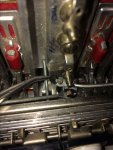Sebastian Bravo
Active member
Hi everyone, i'm feeling a bit sad because of this problem...
Yesterday, i finally recieved a Hohner Morino VI N from Europe (i live in Chile)
I was so anxious, so i opened the box as fast as i could, and i put the big instrument on my table. It looks in perfect condition, but when i tested everything, i noticed that the low E, F, and A didn't play, it plays almost all the octaves, but the first octave doesn't produce any sound.
Also, the MIII freebass buttons felt sticky...
So, i opened the instrument, and noticed that the bass pallets were sticking in the borders of the aluminium while in resting position. I tried pushing the pallets and they started opening again (E, F and A), but they are still feeling sticky, i think it's a problem with the glue, i remember reading something about that in the forum but i can't find it.

What can i do to clean the surfaces? is there any possibility to repair it from the inside?
My last resource is to dissasembly all the bass machine, but 185 bass feels way to difficult to my experience...

(after pushing the pallets, the low E doesn't close correctly, so i think there must be also a problem with the wax of the pallets, or the springs)
Any help or suggestions?
Update: Found another sticky pallet but in the treble side (D#5) but that seems to be a lot easier to fix
Yesterday, i finally recieved a Hohner Morino VI N from Europe (i live in Chile)
I was so anxious, so i opened the box as fast as i could, and i put the big instrument on my table. It looks in perfect condition, but when i tested everything, i noticed that the low E, F, and A didn't play, it plays almost all the octaves, but the first octave doesn't produce any sound.
Also, the MIII freebass buttons felt sticky...
So, i opened the instrument, and noticed that the bass pallets were sticking in the borders of the aluminium while in resting position. I tried pushing the pallets and they started opening again (E, F and A), but they are still feeling sticky, i think it's a problem with the glue, i remember reading something about that in the forum but i can't find it.

What can i do to clean the surfaces? is there any possibility to repair it from the inside?
My last resource is to dissasembly all the bass machine, but 185 bass feels way to difficult to my experience...

(after pushing the pallets, the low E doesn't close correctly, so i think there must be also a problem with the wax of the pallets, or the springs)
Any help or suggestions?
Update: Found another sticky pallet but in the treble side (D#5) but that seems to be a lot easier to fix
Last edited by a moderator:




























